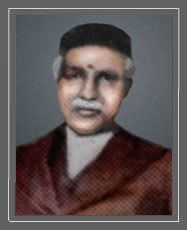
Thana, 13th September, 1936
In 1916, by Baba's grace, I was saved from a watery grave. There was Plague at Dahanu and I had daily to cross a creek between my house and my office. One day I returned from the office very late and there was no ferry boat. I then took a toni (Tamil “thoni" or Canoe) with a boy to paddle, and it got upset in the middle of the creek. I had swerved just a bit but that was enough to make the little canoe capsize. From the time it capsized I had my dhyana of Sai Baba. The boy who was rowing or paddling the canoe was a good swimmer and a resourceful lad. He asked me to hold on to a rope that was above water connecting a buoy with a ship which was at a little distance from us. I caught it and with its help kept my head above water. The boy hallooed to the ship and the shipmen sent us a boat and saved us.
In 1919, I had a son born to me; and this was the first son born after Baba gave my wife the coconut, with blessings from his mouth and with tears in his eyes. We named him Kaluram. To explain Baba's tears a few facts about Kaluram's short life of eight years may be mentioned. He was born under the constellation Moola. When the boy was only three years old he was always repeating the mantra 'Ram Hari Ram’. It was in 1921, i.e., when he was entering on his third year, the effect of Moola was seen. His mother i.e., my first wife, died. No doubt the deeply sympathetic heart of Baba saw her coming end when he gave her the "blessing" (?) for a child to be born under Moola. Anyhow, one might suppose that there was the mitigation of the sorrow in having brought a saintly infant prodigy into existence. But see what followed even in that matter. The boy was stunning the imagination of all that became acquainted with him. A pious and learned neighbor, named Hegde, watched him and declared that he was an incarnation of that playmate of Sri Krishna on whose back the latter got up to invade curd-pots. The boy himself stated occasionally "Krishna used to tease me. I caught hold of Hari's leg and pinched them. I looked up. Hari (who was standing above me) upset the curd-pot over my face. Then the lady of the house turned up, etc." The boy sometimes anticipated Hegde's daily study of "Hari Vijaya" and declared what stories or incidents formed the subject matter of the portion to be read on the particular day by Hegde. I saw him one day seated in a corner, with his head covered by a cloth. He was motionless and steady like one immersed in Yoga. His eyeballs were upturned, but the cloth over his head that was worn like a cowl hid the eyes from my view. I lifted the cloth and asked him why he was covering his head. He said he was always doing so. Asked why he went on with his course of Sadhana, he laughed. His precocity surprised me greatly. Once he asked me to get for him the latest special issue of a journal (Sandesh). When that was brought, the first picture on it was Sri Krishna's encircled by the Pranava "Aum". Kalu cut out that picture and stuck it on the wall. Then there was the advertisement of "His Master's Voice" records with the picture of the dog before the gramaphone. Kalu's interrogation thereon was typical of him.
Kalu: What is this?
I: It is the advertisement of a phonograph.
He: It is a special message of Krishna.
I: What is the special message?
He: What is the dog hearing?
I: The music played by the plate.
He: The dog hears his master's voice. See the dog, so steady from head to tail, intently listening. We must be equally firm and steady. See how I sit. You also should sit like that and listen and then you will hear Baba's voice.
I: How do you know Baba's voice?
He: I know. I will not tell you. Experience it yourself.
In addition to his oral Japa of "Ram Hari Ram," Kaluram was going on writing that mantra in chits and a quantity of them were with us. When Upasani Baba came to Andheri, he said he wanted such chits and they were handed over to him. In 1924 Gadgi Baba came over to my house to see this boy. In 1926, Kalu had dropsy and low fever. We gave him only Baba's Udhi. The disease continued for a while. On Kartik Sudha Ekadasi (so piously celebrated by thousands of pilgrims at Pandharpur and other Vishnu Sthalas), Kaluram approached his end. He called me to his bedside and asked for Jnaneswari. It was at once produced. He himself opened it and picked up the XIII Chapter. At that time I was feeling the sadness of the approaching end, the bitterness that we had to part with such a son. But Kalu cheered me up and said, "What is there to cry for? Read this (Ch. XIII). Read it aloud for me. I am going to-day." My heart was sinking under a load of grief and I could not read it. Then he kept the book in front of him and breathed his last. A fitting termination, this departure on Kartik Ekadasi, was for such a life. But yet how sad was such an early death? No wonder that Baba wept in 1918 when he gave the coconut and clearly perceived that such an early death was to crown such a life.


